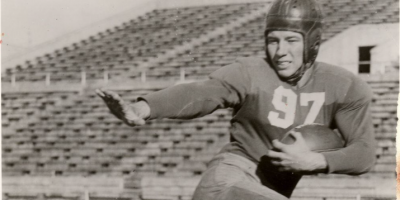
By — Seth Ellerbee
Today, on the 23rd anniversary of the September 11th attacks, one can’t help but be patriotic while thinking of the servicemen and women who answered the call to arms throughout generations.
It’s a beautiful and often sad human emotion, patriotism. It brings together the strongest and bravest of generations and protects the freedoms which we hold dear. And it sends our best to sometimes spend eternity on a far-off battlefield or to come home to be buried in sacred cemeteries across the country.
And as a life-long Georgia Tech fan and WWII history fanatic, whose grandfather was a grounds crew chief in the 8th Air Force in England in WWII and whose grandmother was buried in her Georgia Tech colors and her Tech lapel pin in 2019, I will always be enamored by Clinton Dillard Castleberry.
In all honesty, not enough people know about him or his story.
The Georgia Tech great – one of the countless pillars of ‘Greatest Generation’ — died at the age of 21, serving his country in 1944 at the height of his football powers in a mysterious fashion that still leaves more questions than answers.
With the third class of the Georgia High School Football Hall of Fame scheduled to be inducted in a little over a month, it’s time for an education on Castleberry, an inductee in the inaugural class.
Castleberry was a standout ‘pony back’ or a modern-day ‘half back’ at the Boys School in Atlanta, later named Grady and now called Midtown. At Boys School, he averaged 171 rushing yards per game and could have gone anywhere to play in college, but he chose to stay home at Georgia Tech.
In the 1930’s and early 1940’s freshman were not allowed to play varsity in college but the rule was suspended with college rosters around the country being decimated due to the call to action during World War II.
Castleberry joined the team and became one of the greatest freshman in the history of Georgia Tech football.
On October 3, 1942, Georgia Tech traveled to South Bend, Indiana and beat Notre Dame 13-6, led by Castleberry. The Fighting Irish had not lost in two years and Tech hadn’t beaten them since 1923. Against Navy, a powerhouse at the time, Georgia Tech won 21-0, the shutout solidified by an interception returned 95 yards for a touchdown by Castleberry.
“A magnificent run that I can still follow step by step in my mind. It shook Navy to its keel, and Tech won 21-0,” said Tech head coach Bobby Dodd, who called it Castleberry’s greatest play.
An injury nerfed Castleberry in the final two games of the season – both losses – to Georgia 34-0 at Sanford Stadium and to Texas 14-7 in the Cotton Bowl in Dallas. Georgia Tech finished 9-2 that season and was fifth in the AP Poll, while Castleberry finished third in the Heisman Trophy voting, the highest finish ever for a freshman at the time.
After the Cotton Bowl – and a swift surgery to repair his injury — Castleberry enlisted in the Army Air Forces. He withdrew from Tech, which he planned to re-enroll after service, and reported to Miami, Florida for duty. He attained the rank of Second Lieutenant and was assigned to the Mediterranean theater where he piloted ‘Dream Girl’ a B-26 Marauder based out of Roberts Field in Liberia, Africa.
On November 7, 1944 – four days before Georgia Tech defeated Tulane 34-7 at Grant Field in Atlanta — Castleberry’s plane and another B-26 were tasked with ferrying supplies toward Dakar, Senegal, a flight of roughly 1,600 miles round trip.
The planes were never seen again and that’s that. Gone, without a trace.
A six-day search was initiated, and the crews were listed as missing in action, then, two weeks later, they were declared dead. No evidence of the plane nor the men was ever found.
What do you do when a plane doesn’t come home? What does a fanbase do when their star player is gone without a trace? Georgia Tech’s 1944 football team – which likely heard of the missing in action report by the Tulane game — beat Tulane, then LSU (14-6), lost to Notre Dame (21-0) and then upended the University of Georgia in Athens 44-0.
Was it a German attack? Did the planes run out of fuel because of a gauge malfunction? Was it friendly fire? Were Castleberry and both crews WWII’s version of Pat Tillman, the former NFL star who gave up his career for the Army after September 11th and was then killed by friendly fire in Afghanistan in 2004?
More questions than answers.
For now, Castleberry and his legacy lives in the hearts and minds of Georgia Tech fans and those at the Georgia High School Football Hall of Fame. His number – 19 – is the only one Georgia Tech has retired in its 132-year history.
Someday, I hope there will be a discovery. Plane parts in a jungle or desert or maybe on the ocean floor which can be identified as ‘Dream Girl’ and maybe, just maybe, provide closure to those who held and hold him dear.












































